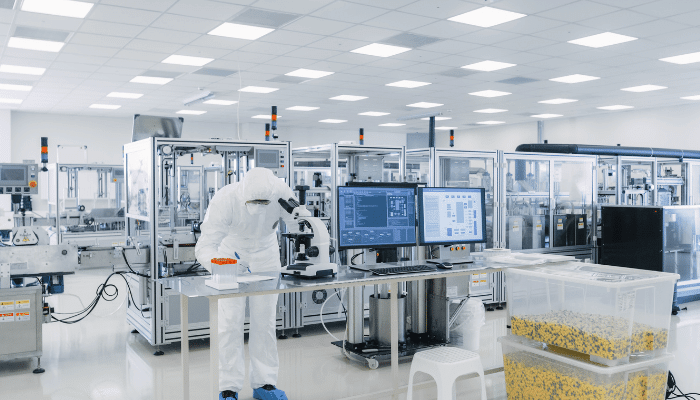What is Data-Driven Manufacturing?
Data-Driven Manufacturing is leveraging data gathered from the plant floor so that everyone in the plant from operators to COO’s can adjust and make improvements to the overall manufacturing process. Data from your equipment allows everyone to make confident decisions based on solid information.
There are many ways that you can acquire data, with some being much more efficient than others. You could hire someone to go to your plant floor, and manually record data from machines with pen and paper or have the operators do it themselves. Although this is a very straightforward concept, it likely is not the best solution for you. Having people manually record data sounds like a simple, efficient, and very straightforward task. However, the data typically recorded on paper ends up being old (once it’s in a state to be analyzed), moderately inaccurate, and limited. The truth is, there is a much more accurate and efficient solution available today.
Implementing an IIoT manufacturing analytics system. These kinds of systems will allow you to pull data directly from the machines on your plant floor, to provide you with data that was never available before, in real-time. Some wonder if we can rely on this data to be accurate, without human interference. As humans, we will make errors, and improperly record data from time to time. IIoT systems pull data from PLCs, controllers, and sensors to pull data right from the equipment. There is nothing in between, it is the most straightforward path possible. This means that you get the most accurate, and detailed information in the quickest way possible. For the data that may not be available from the equipment, HMI or operator data entry screens can be provided for operators to enter the pertinent process, production, quality, and availability/downtime data.
Why You Need to be a Data-Driven Manufacturer
Making decisions with solid substance behind your reasoning is invaluable. We have established that implementing an IIoT system is the best way to gather data. How does the data you are gathering really make such a big difference? There are so many different categories of data that IIoT systems can attain today. You can track downtime with reason codes, production throughput, temperatures, vibration, and scrap just to name a few. That data can then be converted into more valuable information like OEE, downtime Pareto chart with reason codes listed by occurrence or duration, product goals versus actuals during the middle of the day, and more.
If you are tracking these metrics and seeing the real performance, inevitably you will find room for improvement, even in areas where you might have thought you were doing pretty well. Seeing the actual numbers is shocking to most people.
Continuous Improvement
When you are driven by data, you will see all the areas that need improvement. Since you are looking at precise data you will also see exactly how much room for improvement there is in one area. Right from the start, you will clearly recognize your biggest inefficiencies. Now you will know exactly where to focus your efforts. Real-time data will assist you in solving the problem, and getting instant results. In our experience it can take from 1-2 days to 2 weeks to get data recorded manually, data entered into a spreadsheet or database and then converted into usable metrics. The real-time availability of data with IIoT solutions is immensely valuable and puts you right on track to running the most efficient factory possible.
Confident Decisions
Being a data-driven manufacturer can help you in other ways that you might not put much thought into initially. You’re able to make confident data-based decisions. Empirical data including numbers and large amounts of the right data backing up your decision are undoubtedly a massive benefit. You’re able to work in a clearer state of mind, not continuously thinking about a past decision, wondering and hoping that you made the right move. Realistically, you have more than one thing on your plate and the added stress holds you back. When you eliminate the guesswork and know that you made the right decision based on facts, it will help you tremendously. Allowing you to solve issues quickly and effectively, and shift your focus onto the next task.
Why Being Data-Driven will Generate More Revenue for You
IIoT systems, manufacturing analytics, and real-time data are great tools and features to help convert you into a data-driven manufacturer. This is, of course, an investment. Here is how data-driven manufacturing will take your company to the next level by increasing efficiencies, reducing costs, increasing production, and in the end increasing revenue.
Once you see the data, you will have an accurate perspective on efficiencies in your operations. Once you gain that awareness you’re better able to improve efficiencies. You’ll be able to track data to decrease downtime, increase throughput, increase OEE, you will understand your machines better, and move aware from expensive maintenance practices like reactive and preventative to more valuable practices like condition-based monitoring and other efficient and proactive maintenance practices.
Here are some additional areas of plant operations that can be improved with IIoT solutions:
Project Lead Times
This area will be improved if you act upon the data that you are now receiving. More units manufactured faster, as your manufacturing process efficiency is improved, your project and lead time will inevitably go down. Now that you can get projects done faster, you have time for more projects. More projects is more money.
Downtime
Downtime will decrease. Whether it is scheduled or unscheduled downtime, the numbers will improve. Once you have PLCs and sensors installed that allow you to see what is happening inside the machine, you will learn the reasons why that machine might be going down. You will have the historic data to find trends in machine behavior, this will help you avoid unscheduled downtime. You will also know when you will need to schedule maintenance on the machine based on the actual, current health of the machine. Before you were tracking this metric, you might have even been spending too much time on maintenance that the machine did not require. Unscheduled downtime is always bad, but having inefficient scheduled downtime can be just as detrimental. We have another blog post focuesed solely on reducing downtime- If you think you could benefit from reduced downtime check it out here.
Customer Relationships
Improved customer relationships. Your customers will appreciate you engaging in data-driven manufacturing just as much as everyone on the plant floor. Each job has different requirements and a lot of variables. Those variables can cause issues including poor quality and/or late deliveries. If you have historical data and an awareness of current conditions in the plant you can then be more proactive to make adjustments on staffing, routing, shifts, parts and raw materials needed for jobs, etc. You can then give the customer updates with precise and detailed data for when their orders will be delivered. If you can provide more insight into your manufacturing process, you will establish trust and transparency. Happier customers lead to more return customers, better reviews, and a great brand reputation.
Put Yourself in Position to be an Industry Leader
More insight, more throughput, less downtime, happier customer, and smarter employees that have machine insights and make decisions based on the facts. These are many of the traits companies have that are leaders in the manufacturing sector.
Technology is advancing at a quick pace. These capabilities are becoming more and more available to everyone. Being a data-driven manufacturer is not just for the Teslas and the Amazons of the world. Today, it is available to even small-medium-sized businesses. The ones who are taking advantage of this are the ones that are growing, making a name for themselves, and will thrive in the coming decades. Don’t sit back relying on the old way manufacturing has been done for the last 30+ years, put yourself in a position to lead the industry. Seemingly small details are the difference that can make or break your results in the future.






